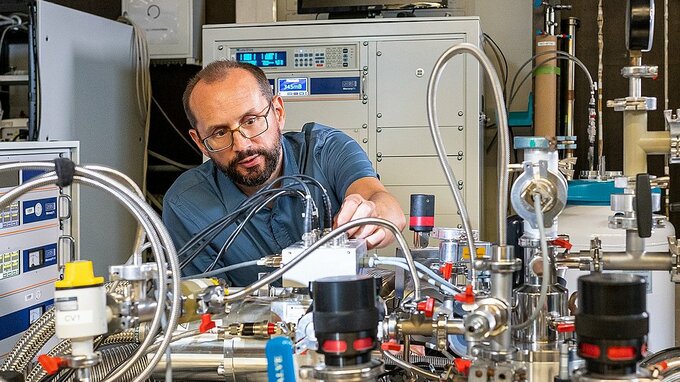Neue Materialien für die Quantentechnologie
Festkörper mit speziellen Symmetrien für Quanten- und Spintronics-Anwendungen
2021-12-23 – Nachrichten aus dem Physik-Department

Als vor rund 15 Jahren mit den topologischen Isolatoren die ersten Vertreter einer neuen Materialklasse entdeckt wurden, waren die Hoffnungen groß: Aufgrund ihrer speziellen elektronischen Struktur erwartete man auf der Oberfläche dieser neuen Materialien besondere Eigenschaften, beispielsweise einen energieeffizienten Informationstransport, mit denen sich völlig neue elektronische Bauteile für eine Vielzahl von Anwendungen entwickeln lassen sollten.
Doch bisher konnten diese Eigenschaften nicht einfach verändert und in Anwendungen kontrollierbar gemacht werden. Trotz größter Anstrengungen ließ deshalb eine technologische Nutzung auf sich warten. Dank der Entdeckung eines Teams um Christian Pfleiderer, Professor für Experimentalphysik zur Topologie korrelierter Systeme an der Technischen Universität München, könnte sich dies nun ändern.
Die Suche nach Kreuzungen
In Atomen besetzen die Elektronen die unterschiedlichen Atomorbitale sukzessive bis zu einer höchsten Energie. Jedes Orbital entspricht dabei einem festen Energieniveau. Im Festkörper überlappen die Atomorbitale, und die Energieniveaus hängen von der Bewegungsrichtung und der Wellenlänge der Elektronen ab. Die Energie der Niveaus für unterschiedliche Bewegungsrichtungen und Wellenlängen variiert dabei innerhalb eines charakteristischen Intervalls, dass als Energieband bezeichnet wird.
Während die Energieniveaus der Orbitale in Atomen in einer bestimmten Reihenfolge ansteigen, kann die Reihenfolge der Energieniveaus im Festkörper, die jeweils aus unterschiedlichen Atomorbitalen entstehen, je nach Bewegungsrichtung und Wellenlänge der Elektronen auch vertauscht sein.
Die Lage der Energieniveaus, die ursprünglich zu unterschiedlichen Orbitalen gehörten, können sich somit für bestimmte Bewegungsrichtungen und Wellenlängen kreuzen. Das heißt, die Energien unterschiedlicher Orbitale sind an den Kreuzungen genau gleich. Besonders interessant sind Materialien, bei denen diese Kreuzungen auf dem Niveau liegen, dessen Elektronen für die Leitfähigkeit verantwortlich sind. Physiker bezeichnen dieses Niveau als Fermi-Energie.
Die Entdeckung topologischer Materialien
Kreuzungen der Energiebänder in echten Materialien kannte man bereits seit den 1930er Jahren. Man fand allerdings, dass diese bis auf sehr wenige Ausnahmen durch die gegenseitige Abstoßung der Elektronen aufgehoben werden. In den Energiebändern beobachtet man dann genau dort wo die Kreuzung erwartet wird eine Lücke. Man hielt Kreuzungen in der Bandstruktur für eine bedeutungslose Kuriosität, da alle bekannten Beispiele für Kreuzungen weit entfernt von der Fermi-Energie auftraten.
Dies änderte sich mit der Entdeckung der topologischen Isolatoren, bei denen die elektronische Struktur der Oberfläche der Materialien Kreuzungen exakt an der Fermi-Energie aufwiesen. Man erkannte zudem, dass hier die Kreuzungen aufgrund des speziellen Charakters der quantenmechanischen Wellenfunktion der Elektronen besonders stabil sind und deshalb nicht durch die Elektronenabstoßung aufgehoben werden.
Bewegung von Informationen ohne Energieverlust
Da bei den Oberflächen der topologischen Isolatoren die Kreuzungen immer am Fermi-Niveau liegen, ergeben sich besondere Eigenschaften für die elektrische Leitfähigkeit der Oberflächen. Insbesondere ist dies die Bewegung elektrischer Ladungen und Spin-Informationen ohne Energieverlust.
Die Entdeckung der topologischen Isolatoren löste eine intensive systematische Suche aus, die zur Entdeckung einer großen Zahl von Materialien mit topologischen Kreuzungen der Energiebänder im Inneren der Materialen führte.
Allerdings war es bisher bei keinem der bekannten Materialien möglich vorherzusagen, ob topologische Kreuzungen exakt auf dem Niveau der Fermi-Energie liegen. Ursache hierfür war, dass die bekannten Kreuzungen nur an Punkten oder entlang bestimmter Linien auftraten, sodass sie höchstens zufällig mit dem Fermi-Niveau übereinstimmten.
Letzteres ist jedoch entscheidend für die technische Nutzung. Kreuzungspunkte mit einfachen Mitteln in Anwendungen zusätzlich ein- und ausschalten zu können, schien darüber hinaus völlig undenkbar.
Schaltbar durch ein Magnetfeld

Wie die Wissenschaftler unter Führung von Dr. Marc Wilde im Team von Prof. Pfleiderer nun zeigen konnten, gibt es Materialien, in denen Ebenen existieren auf denen sich die Bänder immer paarweise kreuzen. Diese werden als Knotenebenen (nodal planes) bezeichnet. Damit ist es sehr leicht eine Kreuzung am Fermi-Niveau zu finden. Nämlich immer genau dort, wo die Leitungsbänder durch eine solche Ebene führen. Zu den ersten Beispielen gehört die Verbindung Mangan-Silizium.
Zusammen mit Dr. Andreas Schnyder am Max-Planck-Institut für Festkörperforschung in Stuttgart konnte das Forschungsteam auch den theoretischen Hintergrund dieses Verhaltens aufklären.
„Eine wesentliche Voraussetzung sind sogenannte „nicht-symmorphe“ Symmetrien. In Mangan-Silizium ist dies eine Drehschraubung der Anordnung der Atome“, sagt Andreas Schnyder. „Damit aber nicht genug.“ so Marc Wilde, „Wir konnten zusätzlich zeigen, dass eine Magnetisierung in einem solchen Material die entscheidenden Symmetrien und damit die Knotenebenen aufheben kann. Damit können wir diese Eigenschaften des Materials ein- und ausschalten.“
Mit dieser Erkenntnis führten Andreas Schnyder und seine Kollegen in Stuttgart eine umfassende Analyse aller bekannten Klassen von Kristallstrukturen durch, um diejenigen zu finden, die die gleichen Eigenschaften besitzen. Dies ist nun die Grundlage für die zukünftige gezielte Suche nach vergleichbaren Materialien.
Besondere Eigenschaften, besonderer Nutzen
„Mit Mangan-Silizium als Beispiel und den jetzt entwickelten theoretischen Grundlagen können wir nun gezielt Materialien auswählen und optimieren“, sagt Christian Pfleiderer. „Diese neuen Materialien könnten nicht nur sehr viel energieeffizientere elektronische Bauteile ermöglichen, sondern auch völlig neue Anwendungen bei denen wir mit äußeren Magnetfeldern die Auswirkungen der Magnetisierung auf die Knotenebenen kontrollieren.“
„So könnten in Zukunft“, hofft Pfleiderer, „diese Materialien sogar topologisches Quantencomputing ermöglichen. Aufgrund der Charakteristiken der Kreuzungspunkte wären entsprechende QBits wesentlich weniger störungsempfindlich.“ Quantencomputer auf dieser Basis müssten dann vielleicht sogar nicht mehr bei Temperaturen nahe dem absoluten Nullpunkt betrieben werden.
- Redaktion
- Dr. Andreas Battenberg
Veröffentlichung
Weitere Informationen
Die Arbeiten wurden gefördert durch das European Research Council (ERC) im Rahmen der Advanced Grants TOPFIT und ExQuiSid, die Deutsche Forschungsgemeinschaft (DFG) im Rahmen des überregionalen Sonderforschungsbereichs TRR80, des Schwerpunktprogramms SPP 2137 „Skyrmionics“ und des Kooperationsprogramms mit der Tschechischen Wissenschaftsstiftung (GACR) sowie der Exzellenzinitiative des Bundes und der Länder im Rahmen des Exzellenzclusters Munich Center for Quantum Science and Technology. Marc A. Wilde, Andreas Bauer und Christian Pfleiderer sind Mitarbeiter im Center for QuantumEngineering (ZQE) der Technischen Universität München, das gegenwärtig auf dem Forschungscampus Garching aufgebaut wird.
Verwandte Meldungen
- Kühlung für Quantenelektronik – 2020-06-12
- Informationstransport durch Magnonen – 2020-12-28
- Wirbel um eingefrorene Magneten – 2020-03-19
- Ausnahmen werden zur Regel – 2019-05-02
Kontakt
- Technische Universiät MünchenJames-Franck-Str. 1, 85748 Garching, GermanyTel.: +49 89 289 14720E-mail: christian.pfleiderer@frm2.tum.de
- Max-Planck-Institut für FestkörperforschungHeisenbergstraße 1, 70569 Stuttgart, GermanyTel.: +49 711 689 1553E-mail: a.schnyder@fkf.mpg.de
